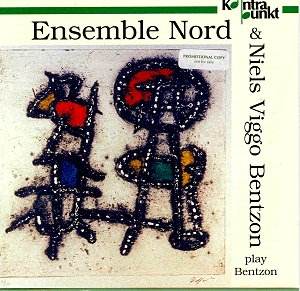Bentzon
was prodigiously productive. Just look at the opus numbers above.
He rivals Hovhaness, Milhaud and Martinu. There are in excess
of 25 symphonies, four operas, eight ballets and more than forty
concertos.
This
recital takes in miniatures from both extremities of his career.
Most of the later pieces were written specially for Ensemble Nord.
These are interspersed with the composer playing his Six September
Moods for solo piano. These pieces are concentrated, fluent,
sincere, eloquent, autumnally contented (tr. 4), a little dissonant
(tr. 2 and tr. 14) and supremely confident. In No. 3 Bentzon crosses,
in modern garb, Bachian fantasy, Cyril Scott's Rainbow Trout
and Finzi-like contemplation. These are not at all hard work to
listen to and would reward the young pianist who is prepared to
seek them out. If you want to programme these as a sequence set
tracks 2, 4, 6, 10, 12 and 14.
The
Six Variations are charming, Gallic, piercing, regretful
(deliciously so at 8.23) and capricious. I did not pick up the
Hindemith influence referred to by the composer. Pyramid is
viewed by the composer as a sister work to Chôro Daniensis
his mosaic tribute to Villa-Lobos in personal echo of the
folk-inspired Chôros of the Brazilian composer. Much
more than Chôro this work proceeds by way of fragile
fragments like a room full of floating broken clockwork. The same
can be said of Tsetse Fly which has a few stinging screeches
as well as some metallic buzzing. There is something of Webern
in this. Each fragment however is tonal and episodes often have
strong rhythmic interest. This probably ties in with Bentzon's
keen interest in jazz.
The
three songs of Cabaret Voltaire are subtitled Drei Dadaistische
Studien für Tenor und Guitar. The composer assures us
that the individual words are not important and as if to affirm
this they are not printed. The poems, all from 1920, are by Theo
von Doesburg, Hugo Ball and Vicente Huidobro. The singer sings,
falsetto, whispers and generally runs the gamut of twentieth century
stage-craft. Once again each element is tuneful just disconcertingly
juxtaposed.
The
Mosaique shows the usual Bentzon traits of fragmentation
and immersion in the melodic-episodic. The earliest piece on the
disc is the Violin Sonata from 1939. It plays for only 6:09. There
is greater line-continuity here - often flighty and liquidly flowing
but also taking a gaunt Bachian line from the Sonatas and Partitas
as at 04:06.
The
liner notes, which are not without humour, are by the composer
though they make no reference to the September Moods which
may well have been added at the last moment.
Ensemble
Nord was founded by a group of artists from North Jutland. It
comprises flute, clarinet, cello, piano, guitar and percussion
- a far from obvious mix.
Rob
Barnett
